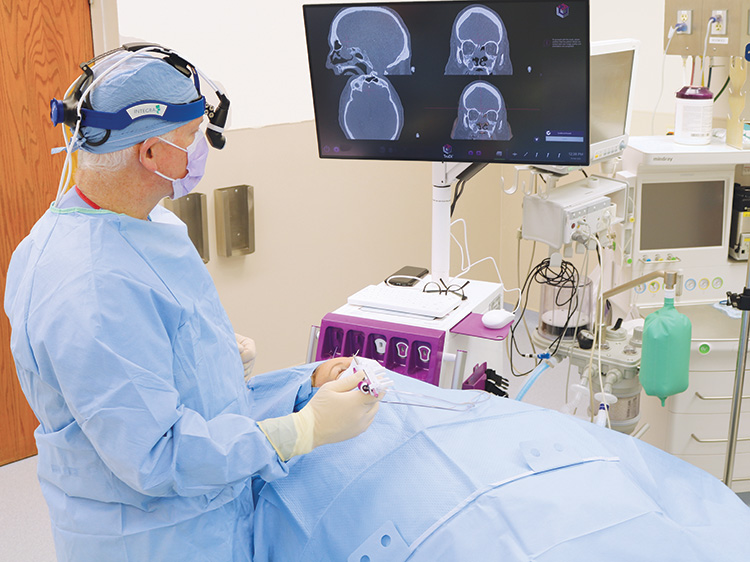ENT (ear, nose and throat) services at WinnMed in Decorah are provided by a full-time otorhinolaryngologist, a specialized ENT who also provides medical and surgical care for the head and neck.
Diagnostic and therapeutic services for patients include:
At WinnMed, a team including an otorhinolaryngologist (ear, nose, throat, head and neck surgeon), an audiologist, and a speech and language pathologist provide quality, local care to patients of all ages.

Sinusitis is a temporary inflammation of the sinus lining that is caused by a bacterial infection and commonly called a sinus infection. Your doctor may recommend saline nasal sprays, antibiotics, nasal steroid sprays, decongestants and over‐the‐counter pain relievers to help relieve the condition.
However, if you experience symptoms for longer than 12 weeks you could have chronic sinusitis.
Balloon Sinuplasty is a breakthrough procedure that relieves the pain and pressure associated with chronic sinusitis or chronic sinus blockage. It is used by surgeons to safely and effectively treat chronic sinusitis patients who are not responding well to medications such as antibiotics, nasal steroids, or over‐the‐counter (OTC) drugs, and are seeking relief from uncomfortable and painful sinusitis symptoms.
Similar to how angioplasty uses balloons to open blocked arteries, Balloon Sinuplasty, a system of FDA‐cleared, catheter‐based instruments, opens blocked sinuses.
The procedure is less invasive than traditional sinus surgery. It allows most patients to return to normal activities quickly.
With Balloon Sinuplasty, a specially‐designed catheter is inserted into the nose to reach the inflamed sinus cavity. A small balloon is slowly inflated, which widens and restructures the walls of the sinus passage, helping to drain mucus from the blocked sinus and restore normal sinus drainage without cutting and with minimal bleeding. This approach also preserves the natural structure of the sinuses.
Patients who suffer from chronic sinusitis and are not responding well to medications may benefit from seeing an Ear, Nose, and Throat (ENT) physician who performs Balloon Sinuplasty to determine if the procedure is right for them. Most insurance companies and Medicare provide coverage for Balloon Sinuplasty.
Learn about 3D Navigation Technology used in Balloon Sinuplasty procedures at WinnMed.
WinnMed offers a minimally invasive option to patients facing tonsillectomies and adenoidectomies (removal of tonsils or adenoids – lymphoid tissue located in the back of the throat).
Coblation Tonsillectomy/Adenoidectomy is a gentle alternative to traditional surgical methods, offering a rapid recovery time and minimal pain. Most patients can even resume normal diet and activities within a few days, up to two-weeks. Coblation Tonsillectomy/Adenoidectomy allows many patients to leave after surgery with less pain and less need for narcotic pain medication.
When the ear drum ruptures, it is vulnerable to infection and other complications. If you experience the following symptoms, seek the care of an otorhinolaryngologist:
Ear drums can rupture from loud blasts such as a gunshot sound, being punctured by a foreign object like a Q-tip or from head trauma. Prevent your ear drum from rupturing by wearing ear protection, keeping objects out of your ears and remembering a helmet when riding your bike. Although the ear drum generally heals itself with time, medical evaluation is recommended to avoid hearing other loss and prevent long-term complications.
If more advanced care is needed, Dr. Remington offers surgical intervention at WinnMed. Procedures are out-patient procedures, and patients generally return home the same day.
Swimmers have increased risk for a condition called swimmer’s ear, an outer ear infection that happens when bacteria or fungi enter tiny cuts in the ear canal.
Water normally flows in and out of the ear canal without causing problems. The ear’s shape and its protective lining (ear wax) guard against bacteria and fungi. But, if water remains in your ear for a long period of time (such as when you are swimming), the wax can dissolve and bacteria or fungi from contaminated water can penetrate your skin, causing infection.
Swimmer’s ear causes pain and swelling in the outer ear. Generally, moving or pushing on the outer ear is very uncomfortable, your ears may itch, you may notice drainage from the infected ear and sounds may become muffled due to swelling.
Swimmer’s ear is most common in children and young adults; however, older adults may also be affected. If an adult has an underlying medical condition such as diabetes, their immune system may be impaired. Diabetic patients are more susceptible to severe cases of swimmer’s ear that may be difficult to treat.
Although swimmer’s ear is painful, treatment is generally not an emergency. To clear the infection, topical medications may be applied after the area is cleaned by a doctor. Oral medications may be prescribed to accompany the use of antibiotic eardrops.
The best way to avoid swimmer’s ear is through prevention practices:
Patients generally need to wait one week to ten days after treatment begins to get back in the water, but each situation is different due to the severity of the infection. Follow your doctor’s suggestions; they will provide instructions personalized for you.
Ear, Nose and Throat specialty appointments can be made by calling WinnMed at 563-382-2911. You can also request an appointment through MyChart.